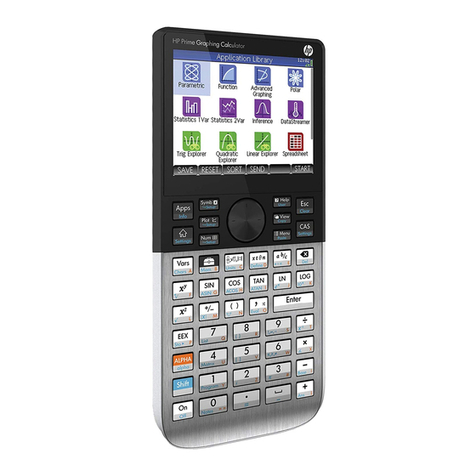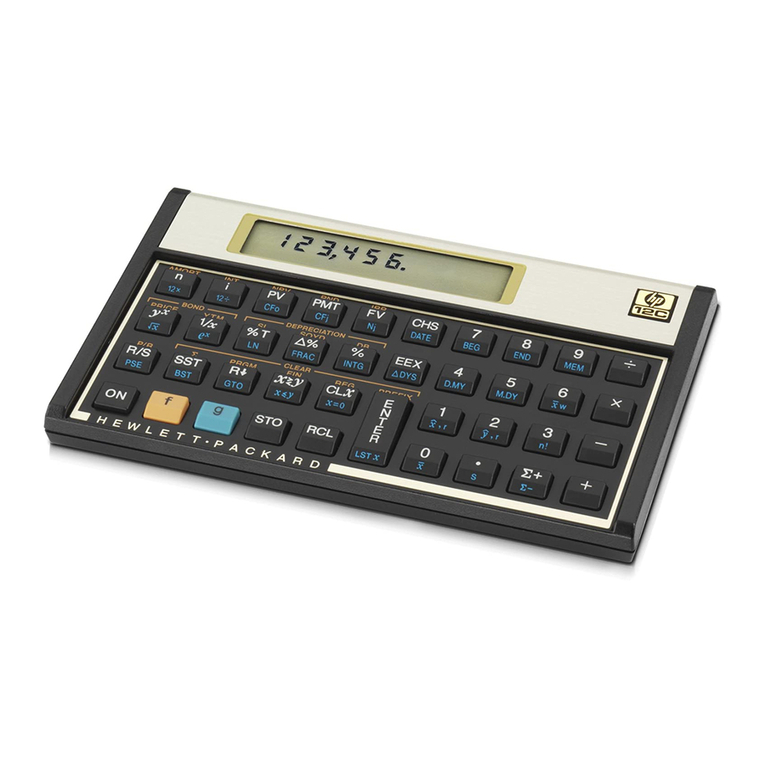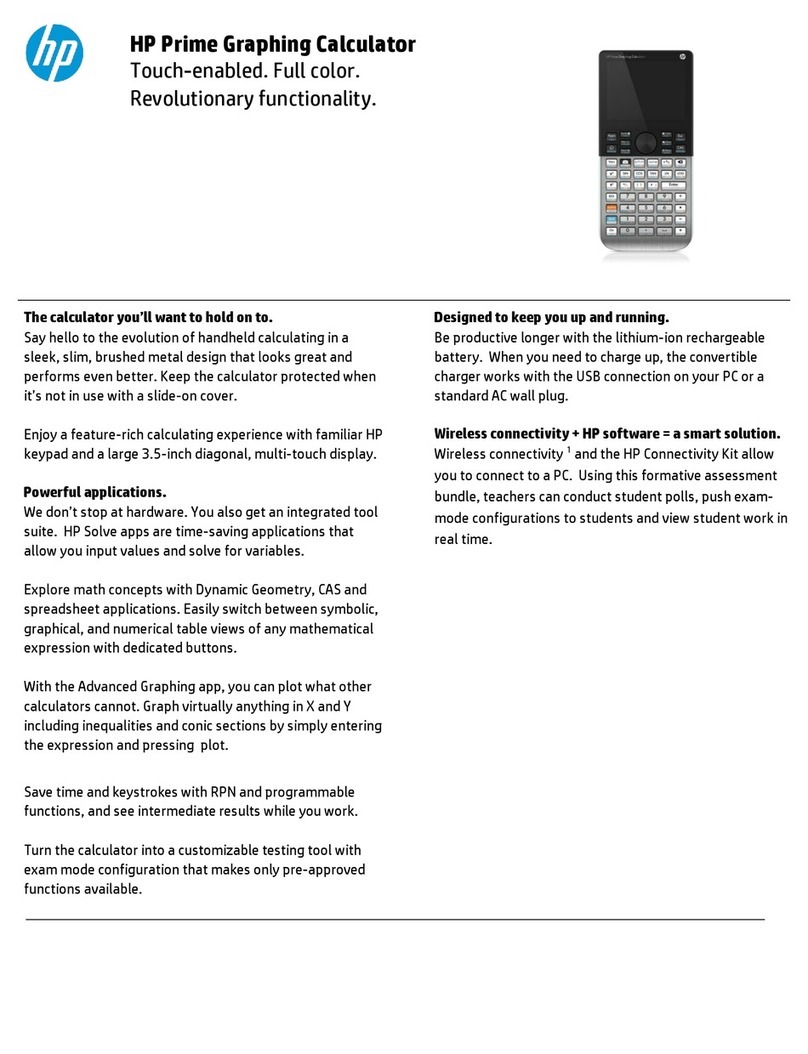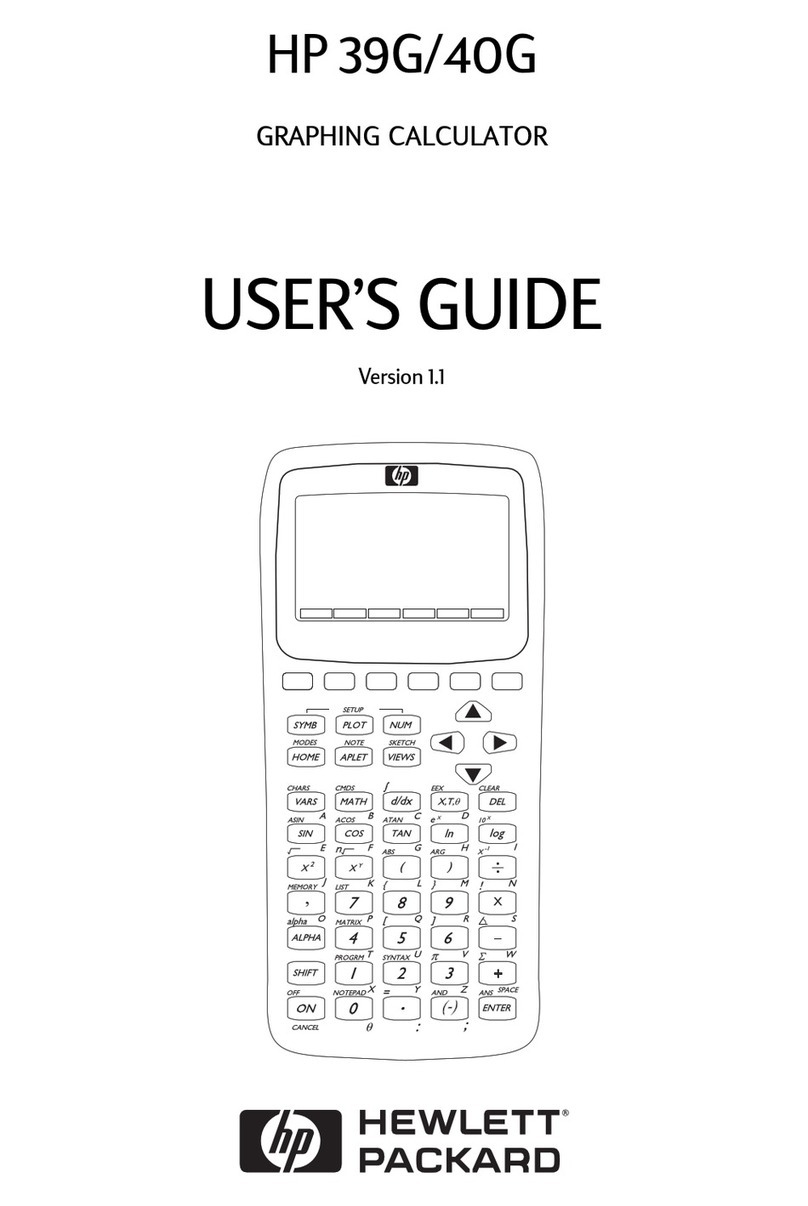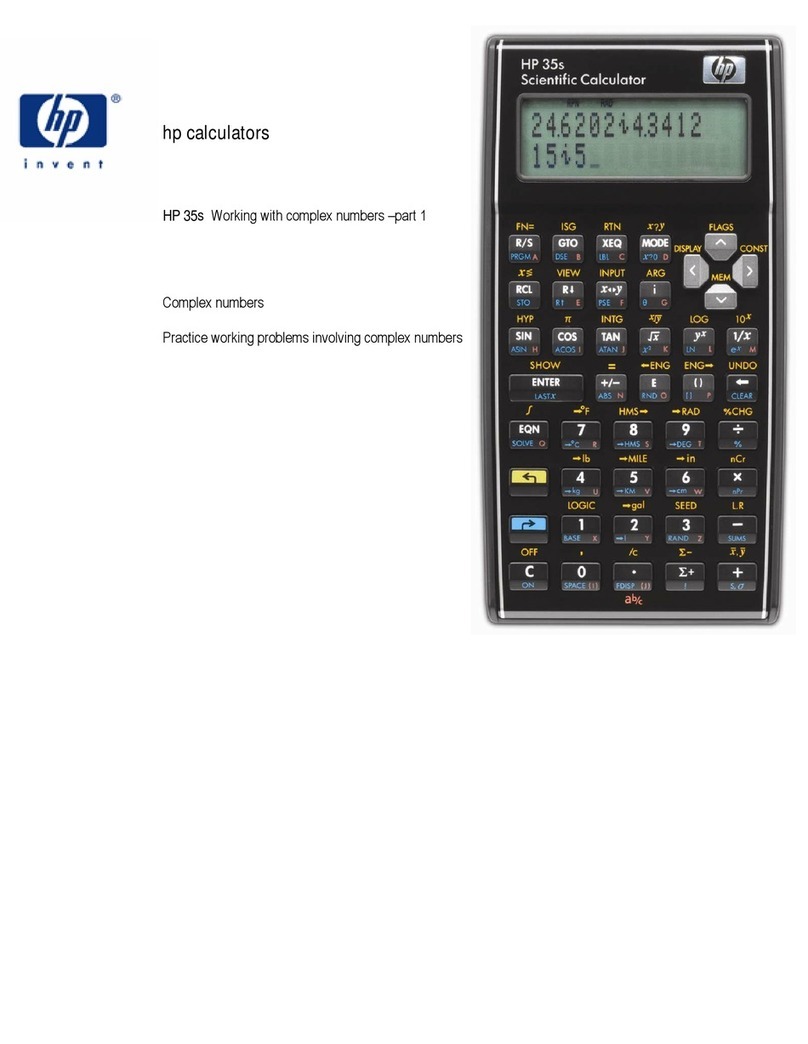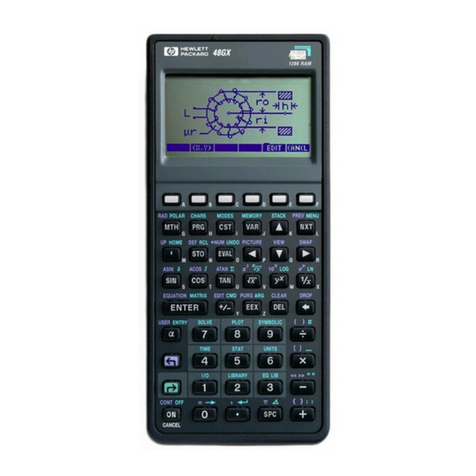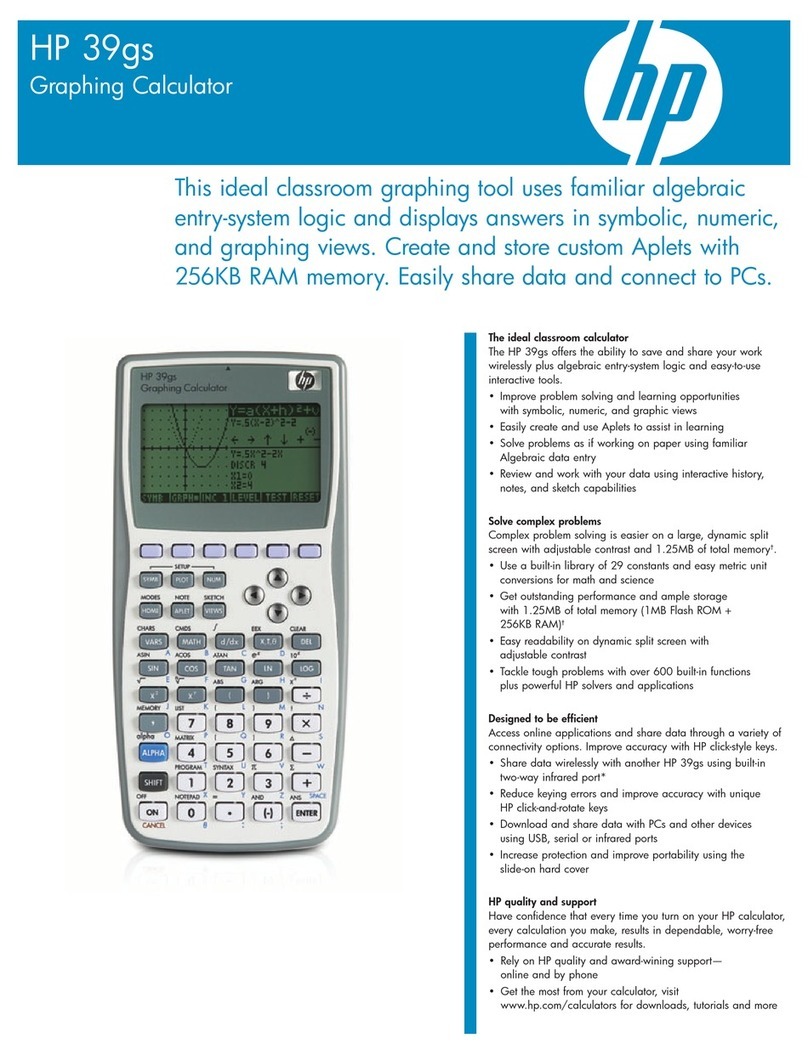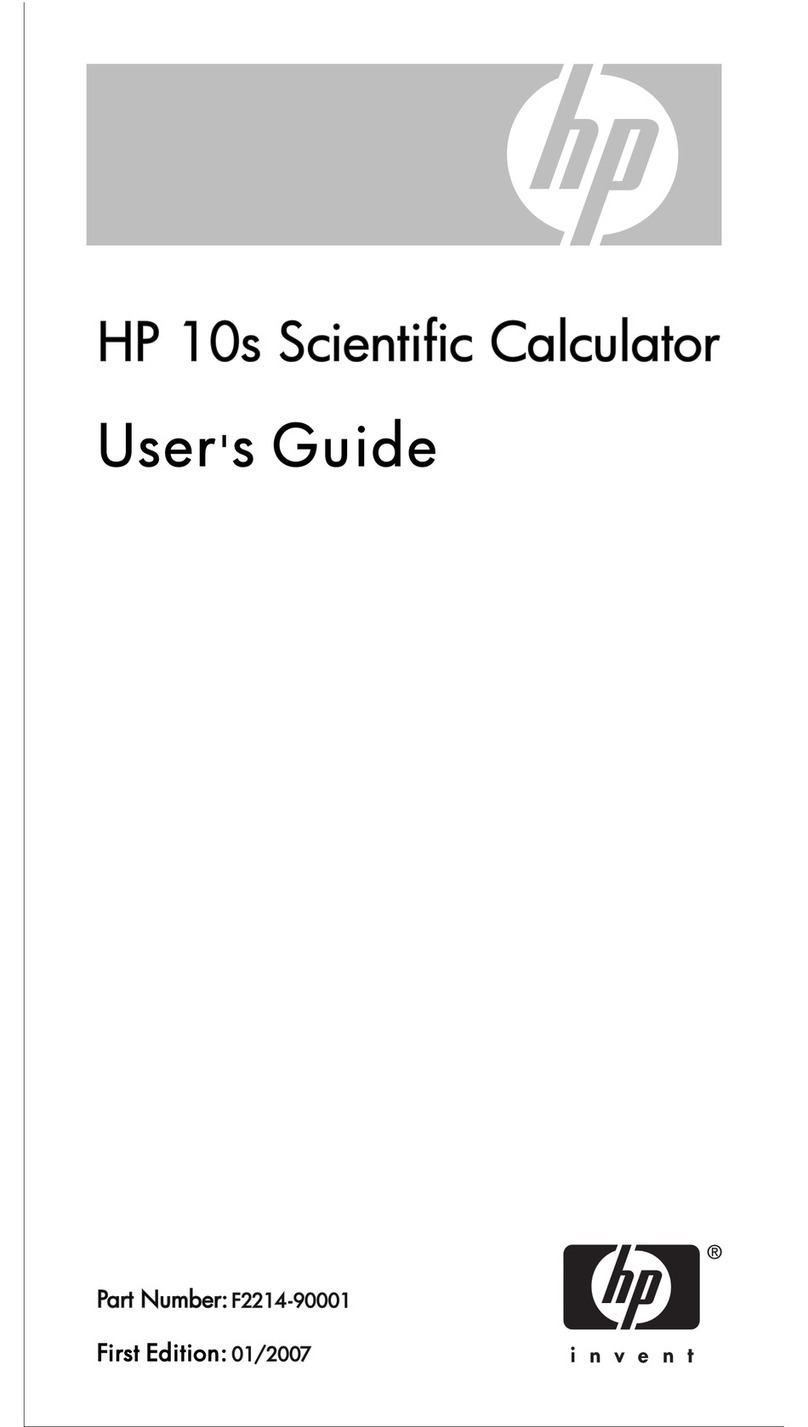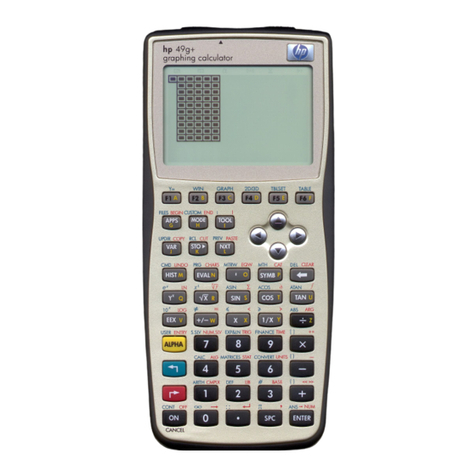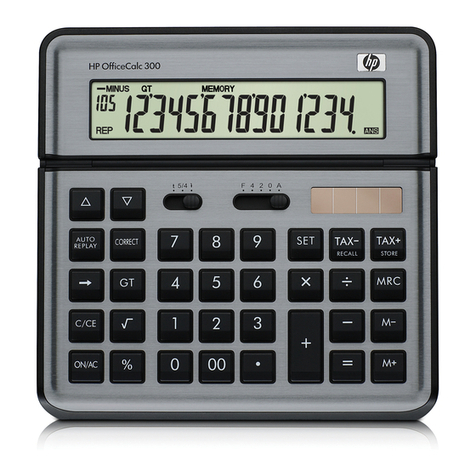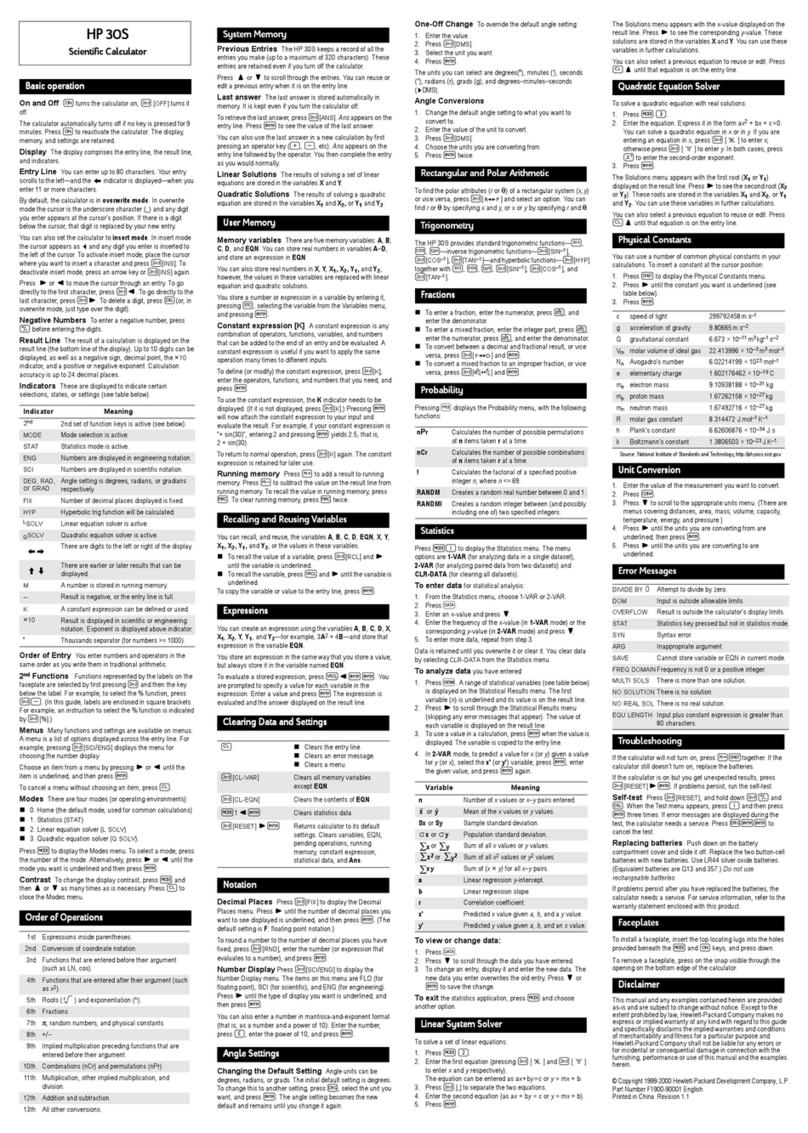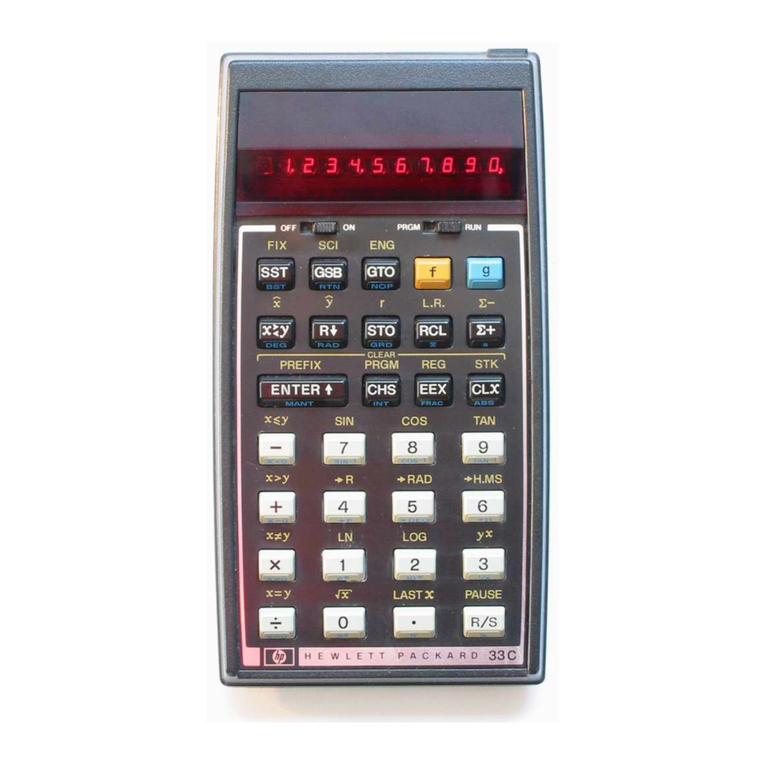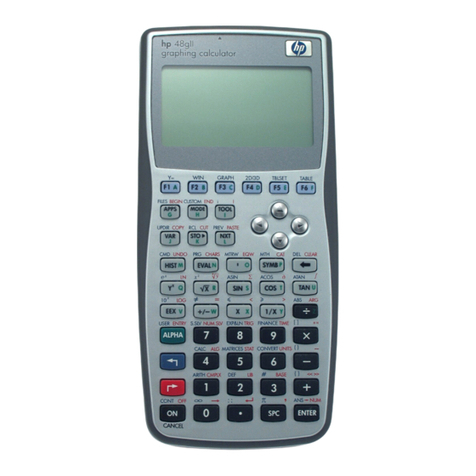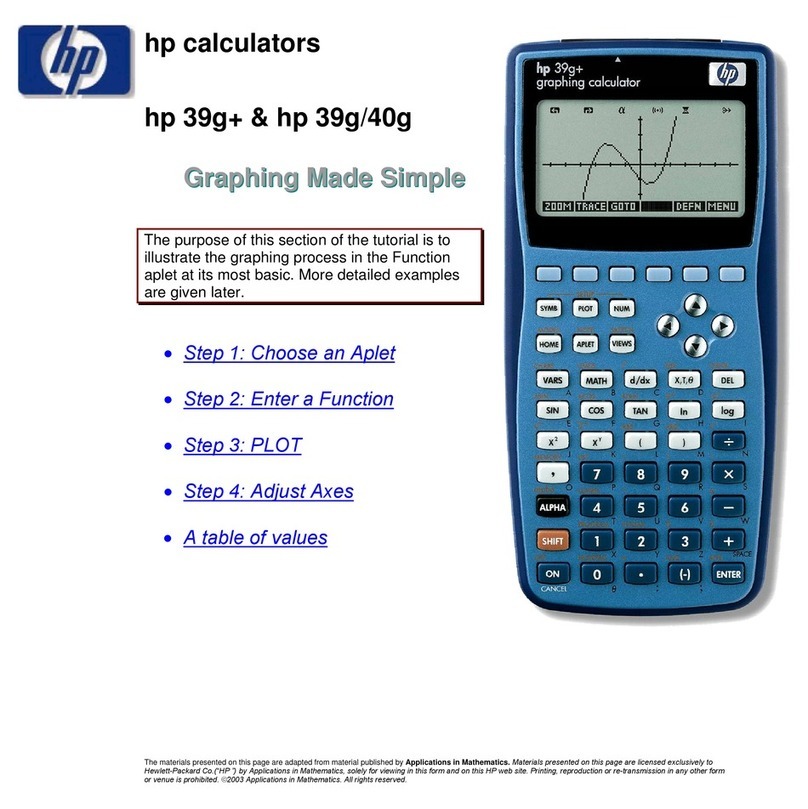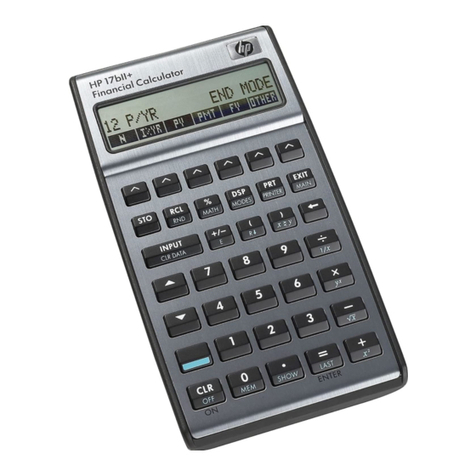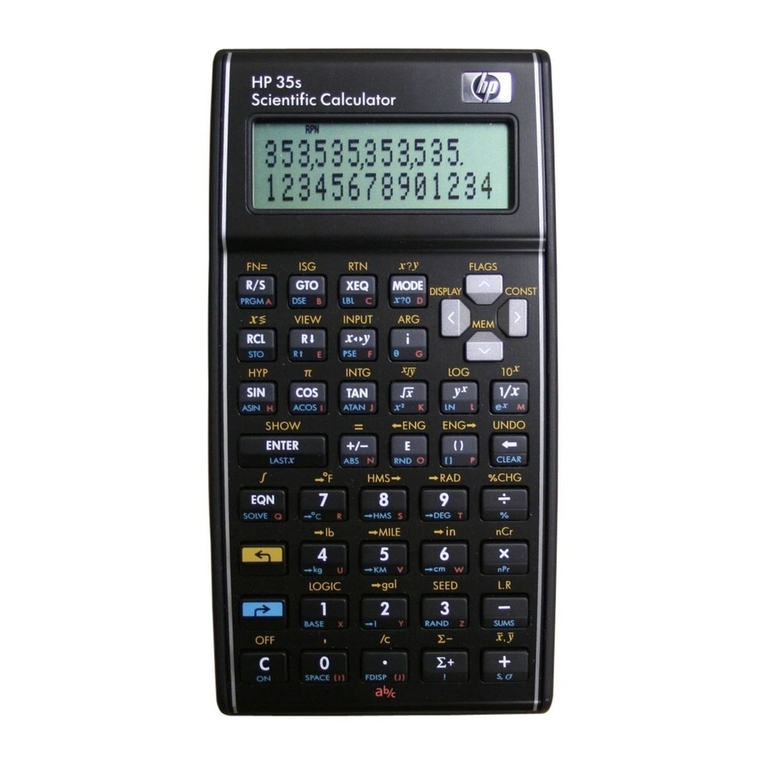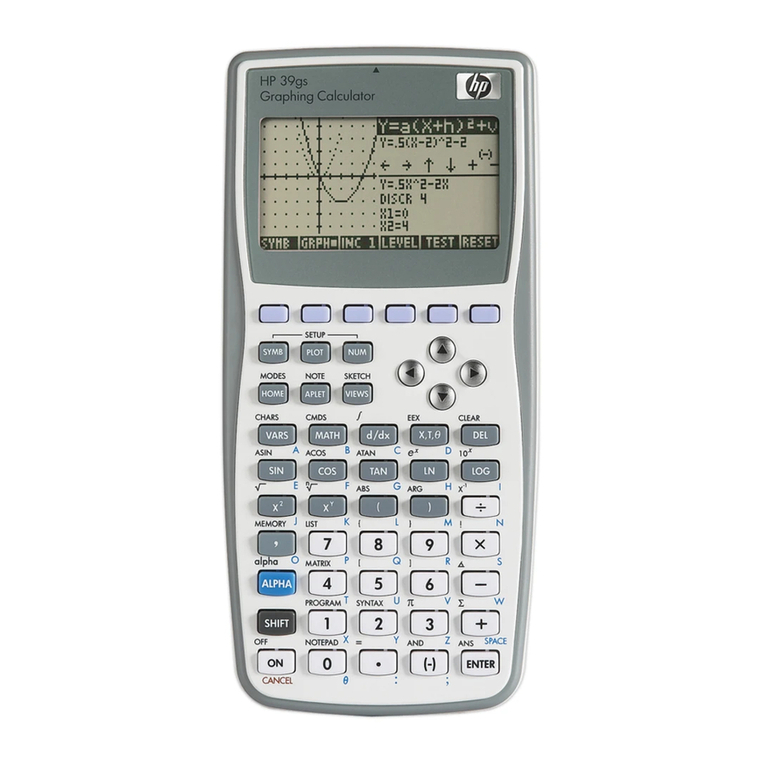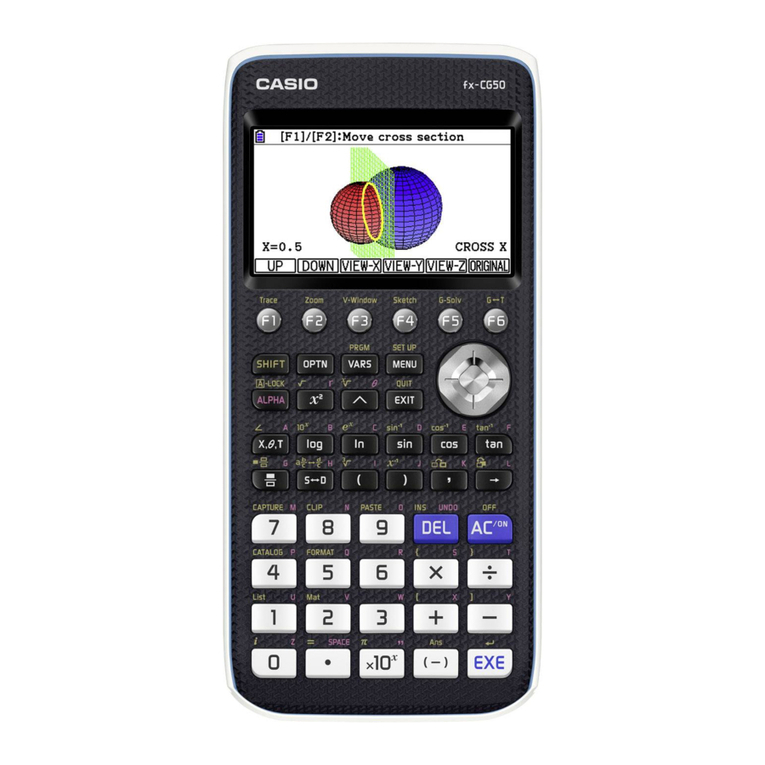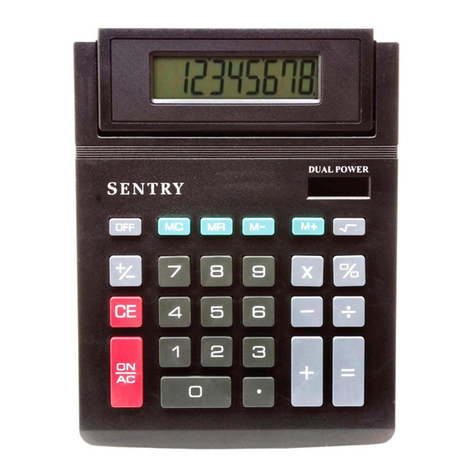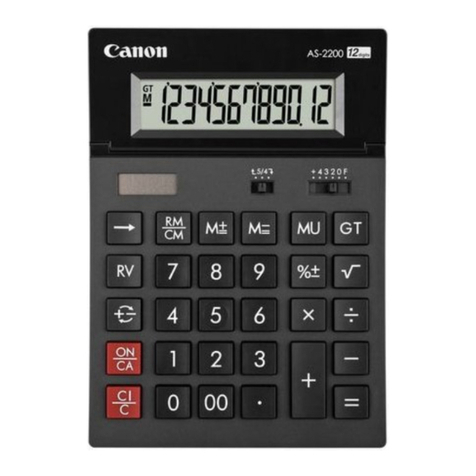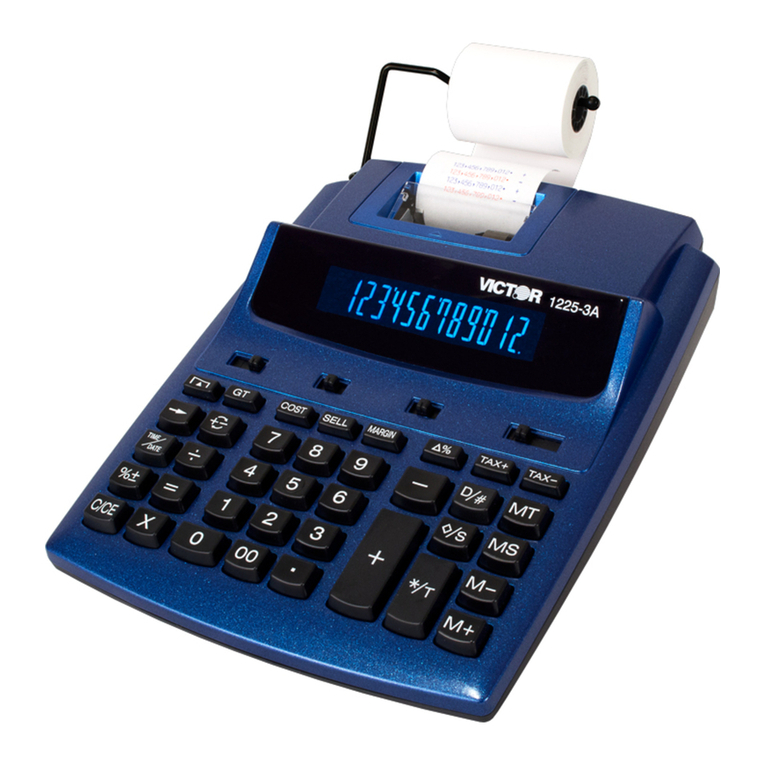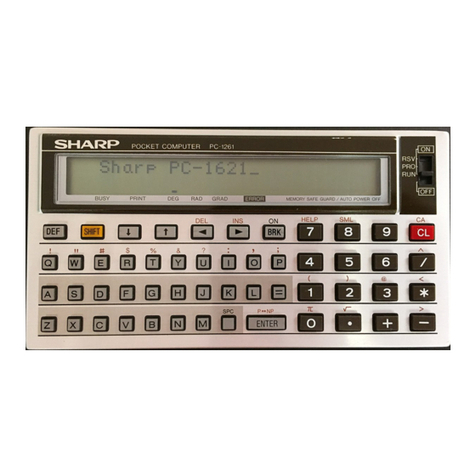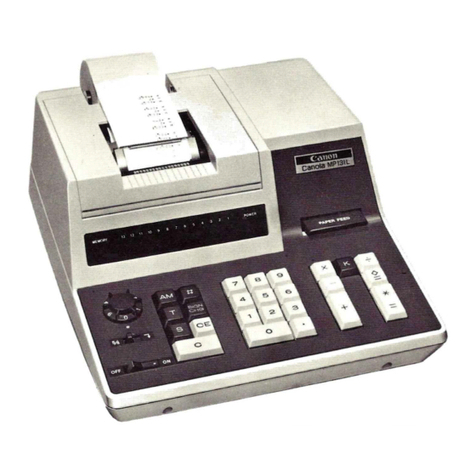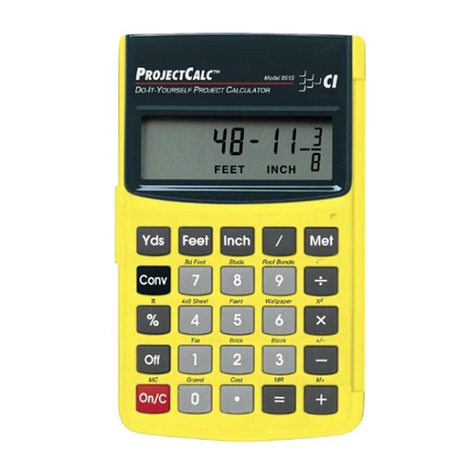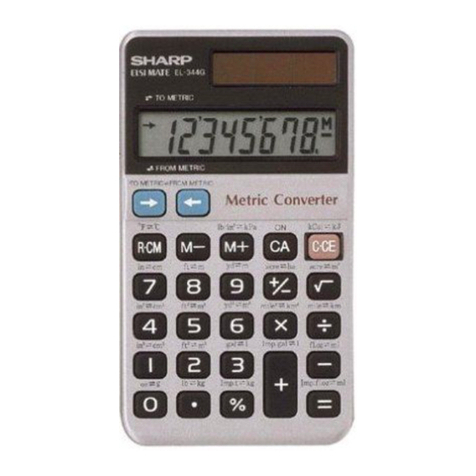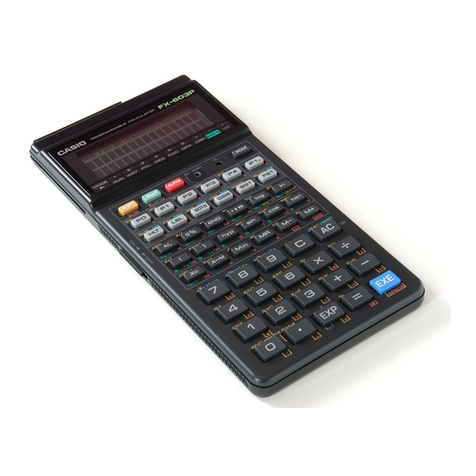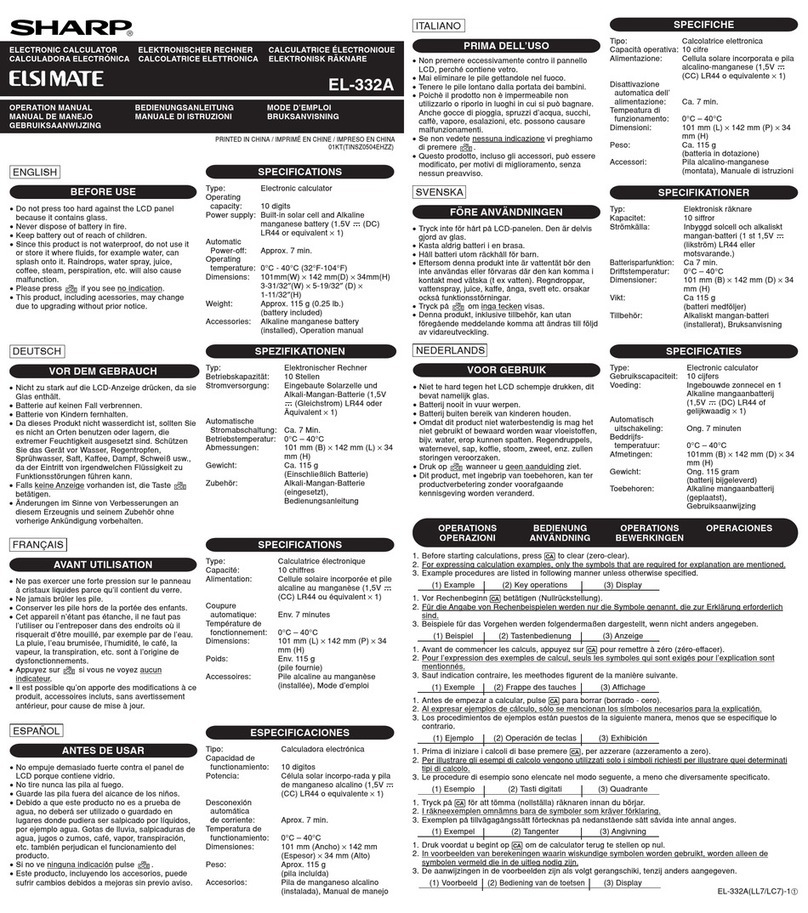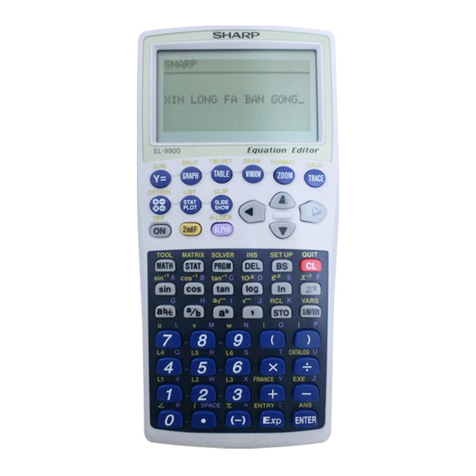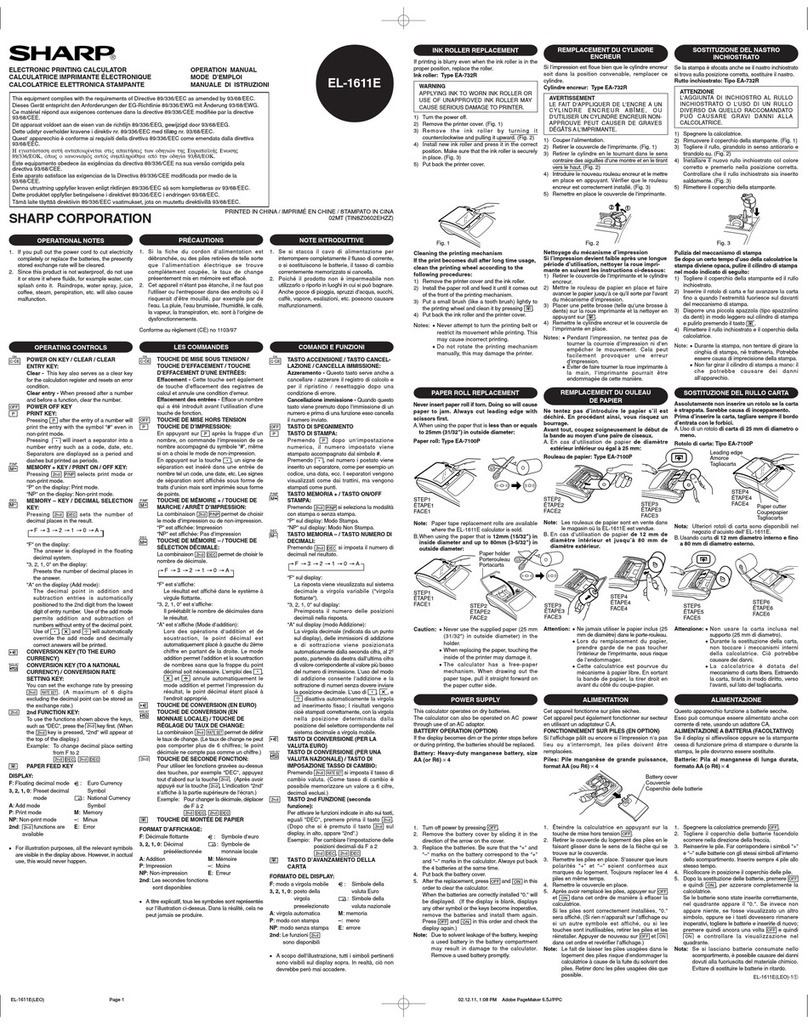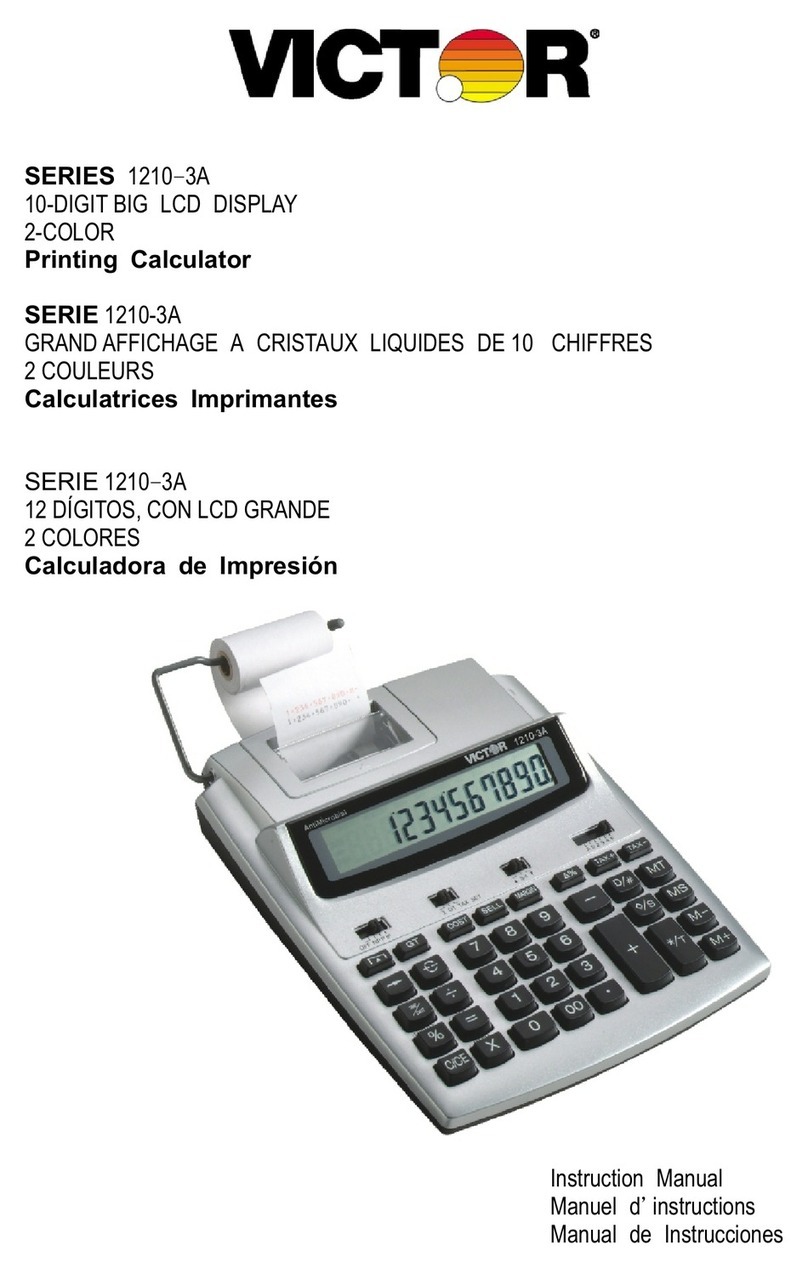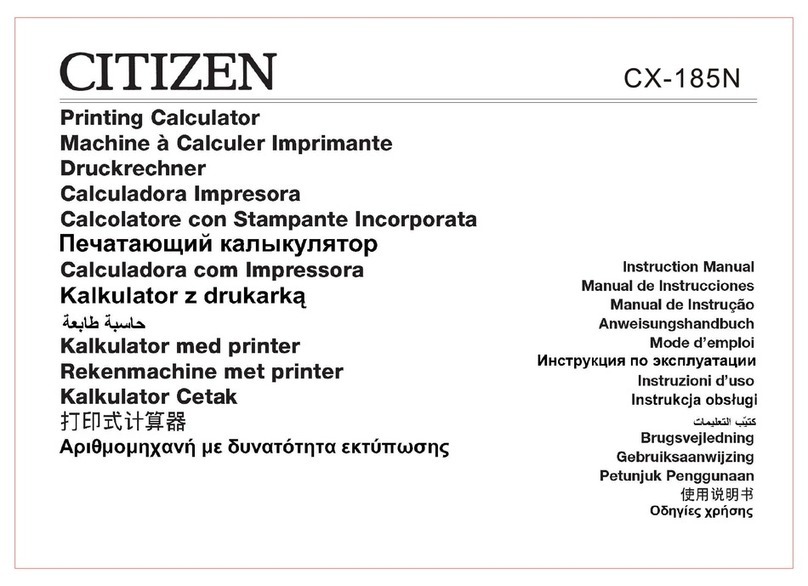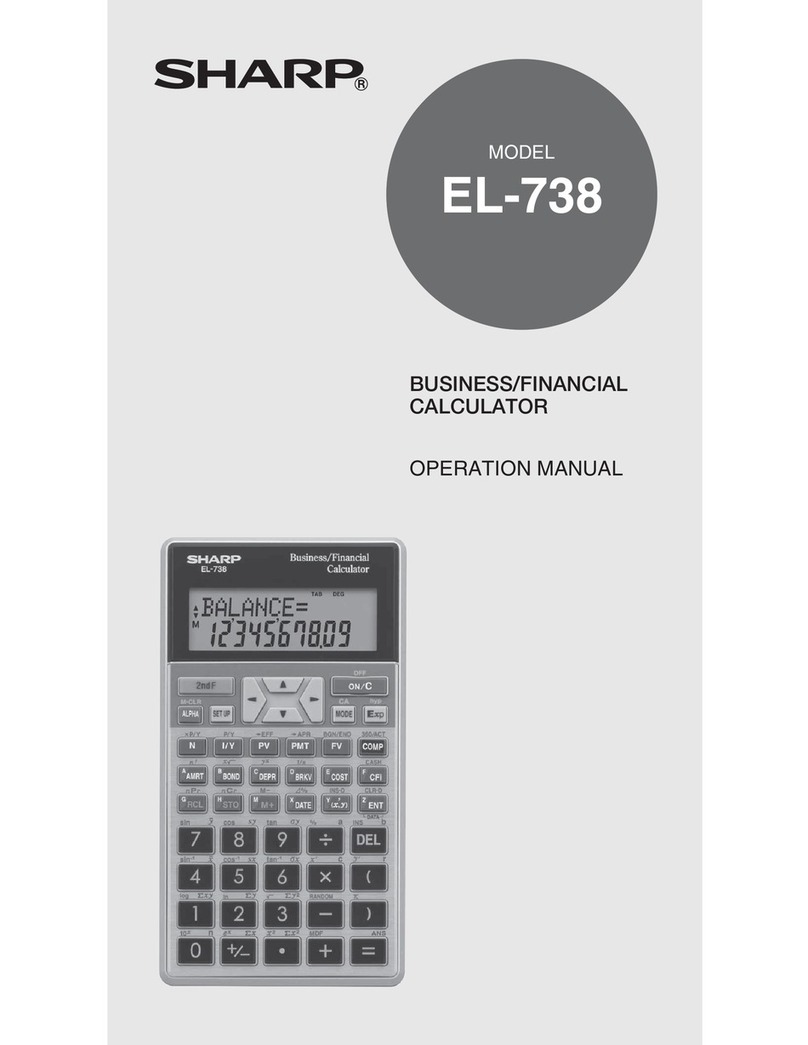HP HP-28S User manual

HP-28S
Flin-
HEWLETT
~I:..
PACKARD

Hp·28S
Advanced Scientific Calculator
Owner's
Manual
r/i;'
HEWLETT
.:~
PACKARD
Edition 4 November
1988
Reorder Number 00028-90066

Notice
For warranty and regulatory information for this calculator, see pages 291
and 295.
This manual and any examples contained herein are provided
"as
is" and
are subject to change without notice. Hewlett-Packard Company makes
no
warranty
ofany
kind
with
regard
to this manual, including,
but
not
limited to, the implied
warranties
of merchantability
and
fitness for a
particular
purpose. Hewlett-Packard Co. shall not
be
liable for any
errors
or
for incidental
or
consequential damages in connection with
the
furnishing, performance,
or
use of this manual or the keystroke programs
contained herein.
© Hewlett-Packard Co. 1988. All rights reserved. Reproduction, adapta-
tion, or translation of this manual
is
prohibited without prior written per-
mission of Hewlett-Packard Company, except as allowed under the copy-
right laws.
The
programs that control your calculator are copyrighted and all rights
are reserved. Reproduction, adaptation, or translation of those programs
without prior written permission of Hewlett-Packard Co.
is
also
prohibited.
Corvallis Division
1000 N.E. Circle Blvd.
Corvallis,
OR
97330, U.S.A.
Printing History
Edition 1
Edition 2
Edition 3
Edition 4
November 1987
April 1988
June
1988
November 1988
Mfg. No. 00028-90067
Mfg. No. 00028-90128
Mfg. No. 00028-90130
Mfg. No. 00028-90147

Welcome
to
the
HP·28S
Congratulations!
With
the
HP-28S
you
can
easily solve
complicated
problems,
including
problems
you
couldn't
solve
on
a calculator
be-
fore.
The
HP-28S
combines
powerful
numerical
computation
with
a
new
dimension-symbolic
computation.
You
can
formulate
a
problem
symbolically, find a symbolic
solution
that
shows
the
global
behavior
of
the
problem,
and
obtain
numerical results from
the
symbolic solu-
tion.
The
HP-28S
offers
the
following features:
• Algebraic
manipulation.
You
can
expand, collect,
or
rearrange
terms
in
an
expression,
and
you
can
symbolically solve
an
equation
for a
variable.
• Calculus.
You
can
calculate derivatives, indefinite integrals,
and
definite integrals.
• Numerical solutions. Using
HP
Solve
on
the
HP-28S, you
can
solve
an
expression
or
equation
for
any
variable.
You
can
also solve a
system
of
linear
equations. With
multiple
data
types, you
can
use
complex
numbers,
vectors,
and
matrices as easily as real
numbers.
• Plotting.
You
can
plot
expressions,
equations,
and
statistical data.
•
Unit
conversion.
You
can
convert
between
any
equivalent
combina-
tions
of
the
120
built-in
units.
You
can
also
define
your
own
units.
• Statistics.
You
can
calculate single-sample statistics,
paired-sample
statistics,
and
probabilities.
• Binary
number
bases.
You
can
calculate
with
binary, octal,
and
hexadecimal
numbers
and
perform
bit
manipulations.
• Direct
entry
for algebraic formulas,
plus
RPN
logic for interactive
calculations.
Welcome
to
the
HP·28S
3

The
HP-28S Owner's Manual (this
manual)
contains
three
parts.
Part
1,
"Fundamentals,"
demonstrates
how
to
work
some
simple
problems.
Part
2,
"Summary
of Calculator Features,"
builds
on
part
1 to
help
you
apply
those examples to
your
own
problems.
Part
3, "Program-
ming," describes
programming
features
and
demonstrates
them
in a
series
of
programming
examples.
The
HP-28S Reference Manual gives
detailed
information
about
com-
mands.
It
is a
dictionary
of
menus,
describing
the
concepts
and
commands
for
each
menu.
We
recommend
that
you
first
work
through
the
examples
in
part
1 of
the
Owner's
Manual
to
get
comfortable
with
the
calculator,
and
then
look
at
part
2 to
gain
a
broader
understanding
of
the
calculator's
op-
eration.
When
you
want
to
know
more
about
a
particular
command,
look
it
up
in
the
Reference
Manual.
When
you
want
to
learn
about
programming,
read
part
3 of
the
Owner's
Manual.
These
manuals
show
you
how
to
use
the
HP-28S
to
do
math,
but
they
don't
teach
math.
We
assume
that
you're
already
familiar
with
the
relevant
mathematical
principles. For example, to
use
the
calculus
features
of
the
HP-28S
effectively, you
should
know
elementary
calculus.
On
the
other
hand,
you
don't
need
to
understand
all
the
math
topics
in
the
HP-28S
to
use
those
parts
of
interest to you. For example, you
don't
need
to
understand
calculus to
use
the
statistical capabilities.
4
Welcome
to
the
HP-285

Contents
15
How
To
Use
This Manual
15
What's
in This
Manual
16
For More
Information
Part
1: Fundamentals
1
2
Getting
Started
Preliminaries
Opening
and
Closing
the
Case
18
18
18
19
20
20
21
21
25
25
31
Locating
the
Battery Door
and
Printer
Port
Turning
the
HP-28S
On
and
Off
Clearing All
Memory
(Memory Reset)
Adjusting
the
Display
Contrast
34
36
36
37
39
40
Keyboard Calculations
An
Overview
of
the
Calculator
Major
Features
and
Concepts
The
Catalog
of
Commands
Doing
Arithmetic
Entering
and
Displaying
Numbers
Changing
the
Decimal Point
Selecting
Number
Display
Mode
Keying In
Numbers
One-Number
Functions
41
Two-Number
Functions
41
Addition
and
Subtraction
41 Multiplication
and
Division
42
Powers
and
Roots
43
Percentages
Contents
5

43
Swapping
Levels 1
and
2
44
Clearing Objects From
the
Stack
45
Chain
Calculations
47
If
You
Execute
the
Wrong
Function
3
48
Using Variables
48
Introduction
to Variables
49
Creating
a Numerical Variable
50
Recalling a Numerical Variable
50
Evaluating a Numerical Variable
51
Changing
the
Value
of
a Variable
52
Purging
a Variable
52
Changing
the
Name
of
a Variable
54
Creating
a
Program
Variable
56
Recalling a
Program
Variable
56
Evaluating a
Program
Variable
57
Quoted
and
Unquoted
Names
4
58
Repeating Calculations
58
Creating
an
Expression
60
Creating
a Directory
63
Using
the
Solver
To
Repeat a Calculation
66
Using a Different Set
of
Values
68
Using a Different Expression
71
Returning
to
HOME
72
Summary
5
73
Real-Number Functions
73
Trigonometric
Functions
73
Selecting Angle
Mode
74
Using
7r
76
Converting
Angular
Measure
77
Logarithmic, Exponential,
and
Hyperbolic
Functions
78
Other
Real
Functions
79
Defining
New
Functions
6
Contents

6
82
Complex-Number Functions
82
Using Complex
Numbers
84
Using Polar
Coordinates
86
A User Function for Polar
Addition
7
89
Plotting
91
Printing
a Plot
91
Changing
the
Scale
of
the
Plot
93
Translating
the
Plot
94
Redefining
the
Corners
of
the
Plot
97
Plotting
Equations
8
98
The Solver
98
Finding
a Zero
of
an
Expression
100
Finding
a
Minimum
or
Maximum
103
Time Value
of
Money
9
107
Symbolic Solutions
107
Finding
the
Zeros of a
Quadratic
Expression
109
Isolating a Variable
110
Expanding
and
Collecting
112
Using FORM
10
117
Calculus
117
Differentiating
an
Expression
118
Step-by-Step
Differentiation
120
Complete
Differentiation
120
Integrating
an
Expression
121 Symbolic Integration
of
Polynomials
122
Numerical Integration
of
Expressions
Contents
7

11
124
Vectors and Matrices
124
Vectors
124
Keying In a Vector
125
Multiplying
and
Dividing a Vector
by
a
Number
125
Adding
and
Subtracting
Vectors
126
Finding
the
Cross
Product
126
Finding
the
Dot
Product
126
Matrices
127
Keying In a Matrix
127
Viewing a Large Matrix
128
Inverting
a Matrix
128
Finding
the
Determinant
128
Multiplying Two Arrays
128
Multiplying Two Matrices
129
Multiplying a Matrix
and
a Vector
130
Solving a
System
of Linear
Equations
12
131
Statistics
132
Entering
Data
133
Editing
Data
134
Single-Sample Statistics
134
Finding
the
Mean
135
Finding
the
Standard
Deviation
135
Finding
the
Variance
135
Paired-Sample
Statistics
136
Specifying a
Pair
of
Columns
136
Finding
the
Correlation
136
Finding
the
Covariance
137
Finding
the
Linear Regression
137
Finding
Predicted
Values
13
138
Binary Arithmetic
138
Selecting
the
Wordsize
139
Selecting
the
Base
139
Entering Binary Integers
140
Calculating With Binary Integers
8
Contents

14
15
Part
16
17
141
141
143
144
146
147
149
149
150
151
152
152
Unit Conversion
The
UNITS Catalog
Converting
Units
Converting
Unit Strings
Checking
for
the
Correct Units
User
Functions
for Unit
Conversion
Printing
Printing
the
Display
Printing
a
Running
Record
Printing
Level 1
Printing
the
Stack
Printing
a Variable
2:
Summary
of
Calculator
Features
154
Objects
155
Real
Numbers
155
Complex
Numbers
156
Binary Integers
156
Strings
157
Arrays
158
Lists
159
Names
160
Programs
161
Algebraics
161
Expressions
162
Equations
163
Symbolic
Constants
164
Operations, Commands, and Functions
Contents
9

18
166
The Command Line
166
The Cursor
Menu
168
Some Entry Keys
169
Object Delimiters
and
Separators
169
Entry Modes
171 Exceptions
171 Manual Selection of Entry Modes
172
How
the
Cursor Indicates Modes
173
Executing the
Command
Line
173 Editing Existing Objects
174 Recovering
Command
Lines
175
The
Command
Line as a String
19
176
The Stack
176
Review of Stack Concepts
177 Viewing the Stack
177 Manipulating
the
Stack
179
Local Variables
179
Recovering the Last Arguments
180
Restoring the Stack
181 The Stack as a List
20
182
Memory
182
User Memory
182
Global Variables
183
Directories
187 Recovery Features
188
Low Memory
190
Maximizing Performance
21
192
Menus
193 Menus of
Commands
194 Menus of Operations
194
Menus of Variables
195
Custom Menus
10
Contents

22
196
Catalog of Commands
197
Finding a
Command
197
Checking
Command
Use
23
198
Evaluation
199
Data-Class Objects
199
Name-Class
Objects
200
Evaluation
of
Local
Names
200
Evaluation
of
Global
Names
201
Procedure-Class Objects
201
Evaluation
of
Programs
202
Evaluation
of
Algebraics
203
Evaluation of Functions
24
205
Modes
205
General Modes
207
Entry
and
Display Modes
210
Recovery Modes
211
Mathematical
Exceptions
212
Printing
Modes
25
215
System Operations
216
Printing
the
Display
216
Contrast
Control
216
Clearing
Operations
216
Attention
217
System
Halt
217
Memory
Reset
Contents
11

218
Test
Operations
218
Repeating Test
219
Keyboard Test
Part
3: Programming
26
222
Program Structures
222
Local-Variable Structure
223
Conditional
Structures
226
IF
...
THEN
...
ELSE
...
END
226
IFTE (If-Then-Else-End Function)
227
IF
...
THEN
...
END
227
1FT
(If-
Then-End
Command)
227
Error Traps
228
Definite Loop Structures
228
START
...
NEXT
229
FOR counter
...
NEXT
230
...
increment STEP
231
Indefinite Loop Structures
231
DO
...
UNTIL
...
END
232
WHILE
...
REPEAT
...
END
233
Nested
Program
Structures
27
234
Interactive
Programs
234
Asking for
Input
235
Asking for a Choice
235
A More
Complicated
Example
28
240
Programming Examples
241
Box
Functions
241
BOXS (Surface of a
Box)
244
BOXS
Without
Local Variables
245
BOXR
(Ratio
of
Surface to Volume
of
a
Box)
246
Fibonacci
Numbers
247
FIBl (Fibonacci
Numbers,
Recursive Version)
248
FIB2 (Fibonacci
Numbers,
Loop Version)
249
Comparison
of FIBl
and
FIB2
250
Single-Step Execution
12
Contents

253
Expanding
and
Collecting Completely
253
MULTI (Multiple Execution)
255
EXCO (Expand
and
Collect Completely)
257
Displaying a Binary Integer
257
PAD
(Pad
With
Leading
Spaces)
258
PRESERVE (Save
and
Restore Previous Status)
259
BDISP (Binary Display)
262
Summary
Statistics
263
SUMS
(Summary
Statistics Matrix)
265
1;GET (Get
an
Element
of
1;COV)
266
1;X2
(Sum
of
Squares
of
x)
266
1;Y2
(Sum
of Squares
of
y)
267
1;XY
(Sum of
Products
of
x
and
y)
270
Median
of Statistics
Data
270
SORT (Sort a List)
272
LMED
(Median
of a List)
273
MEDIAN
(Median
of Statistics Data)
275
Changing
Directories
276
UP
(Move to a
Parent
Directory)
277
DOWN
(Move to a Subdirectory)
Contents
13

Appendixes
&
Indexes
A
B
c
D
282
282
286
289
289
289
291
293
295
296
302
306
Assistance, Batteries, and Service
Answers
to
Common
Questions
Batteries
Calculator
Maintenance
Environmental
Limits
Determining
If
the
Calculator Requires Service
Limited One-Year Warranty
If
the
Calculator Requires Service
Regulatory
Information
Notes for RPN Calculator Users
Notes for Algebraic Calculator Users
Menu Map
327
Key Index
332
Subject Index
14
Contents

How
To
Use
This Manual
If
you
have
the
time
and
inclination, you
can
read
this
manual
from
front to back, working every example.
If
not, we
recommend
the
fol-
lowing
approach
for
getting
started.
1.
Read
the
first five
chapters
in
part
1,
"Fundamentals," to get
comfortable
with
the
calculator.
2. There are two
appendixes
that
compare
the
HP-28S
with
other
styles of calculators.
•
If
you're
familiar
with
other
Hewlett-Packard
calculators
that
use
RPN,
read
appendix
B,
"Notes for
RPN
Calculator Users,"
on
page
296.
•
If
you're
familiar
with
calculators
that
use
a
form
of
algebraic
entry,
read
appendix
C, "Notes for Algebraic Calculator Us-
ers,"
on
page
302.
3.
If
you're
interested
in a topic covered later in
part
1, you
can
skip
ahead
and
try
the
examples
in
that
chapter.
What's
in This
Manual
Part
1, "Fundamentals,"
demonstrates
how
to work
some
simple
prob-
lems. While solving
these
problems
you'll
learn
the
basics
about
HP-
28S operations, object types,
and
menus.
Part
2,
"Summary
of
Calculator Features,"
builds
on
part
1.
It
provides
more
detail
about
how
to
use
the
calculator,
including
options
and
features
not
discussed in
part
1.
Using
part
2,
you
can
extend
the
examples in
part
1 to solve
your
own
problems.
How
to
Use
This
Manual
15

Part
3, "Programming," describes
the
programming
features
of
the
HP-28S.
The
last chapter,
"Programming
Examples," contains a series
of
short
programs
that
demonstrate
programming
techniques.
For
More
Information
As you work
the
examples in this
manual,
you
may
have
questions
about
the
features
demonstrated
or
mentioned
in
the
examples. Both
this
manual
and
the
Reference
Manual
contain
additional
information.
•
If
you
have
problems, see "Answers to
Common
Questions"
on
page
282.
• For a brief description
of
what
each key does, see "Key Index"
on
page 327.
• For a brief description
of
the
commands
in each
menu,
see
appen-
dix D, "Menu Map,"
on
page
306.
• For
detailed
information
about
a
menu,
look in
the
Reference
Man-
ual. All
menus
(plus
some
additional
topics)
appear
in
alphabetical
order.
The
contents
of
the
dictionary
are listed
on
the
back
cover
of
the
Reference
Manual.
• For
detailed
information
about
a
particular
command,
look in
the
"Operation
Index"
at
the
back
of
the
Reference
Manual.
There
you'll find a reference to a
dictionary
entry
(usually a
menu)
and
a
page
reference to
the
particular
command.
16
How
To
Use
This
Manual

Fundamentals
Page
18
1:
Getting
Started
34
2:
Doing
Arithmetic
48
3:
Using
Variables
58
4:
Repeating
Calculations
73
5:
Real-Number
Functions
82
6:
Complex-Number
Functions
89
7:
Plotting
98
8:
The
Solver
107
9:
Symbolic
Solutions
117
10:
Calculus
124
11:
Vectors
and
Matrices
131
12:
Statistics
138
13:
Binary
Arithmetic
141
14:
Unit
Conversions
149
15:
Printing

1
Getting
Started
This
chapter
first describes
the
calculator's basic features,
then
dem-
onstrates
a
simple
calculation. Next,
an
annotated
illustration
of
the
keyboard
highlights
the
major
features
of
the
keyboard
and
display.
Last, you'll
learn
about
the
catalog
of
commands,
which
is a
handy
guide to
commands
and
how
to
use
them.
Preliminaries
This section describes
the
calculator's basic features.
Opening and Closing
the
Case
The
calculator
forms
its
own
case,
opening
and
closing like a book.
To
open
the
calculator,
hold
it
with
the
hinge
away
from you
and
open
it
with
your
thumbs.
18
1:
Getting
Started

To
close
the
calculator, fold
the
two sides
together
and
press
until
you
hear
a click.
You
can
fold
back
the
left-hand
side of
the
caI,.::ulator
until
it
is
back-
to-back
with
the
right-hand
keyboard. This
is
handy
for field
work-
when
you
want
to
hold
the
calculator in
one
hand
and
operate
it
with
the
other-or
to
save
space
on
a desk.
Locating
the
Battery
Door and
Printer
Port
With
the
calculator
open,
note
the
location
of
the
battery
door
and
the
printer
port.
;+--..;-
Printer port
~~.;....-----.;-
Battery door
The
HP-28S
is
powered
by
three
N-cell alkaline batteries. Batteries
are
included
with
the
calculator.
If
the
batteries
are
not
already
in-
stalled, follow
the
instructions
that
start
on
page
286.
1:
Getting
Started
19
Other manuals for HP-28S
2
Table of contents
Other HP Calculator manuals
